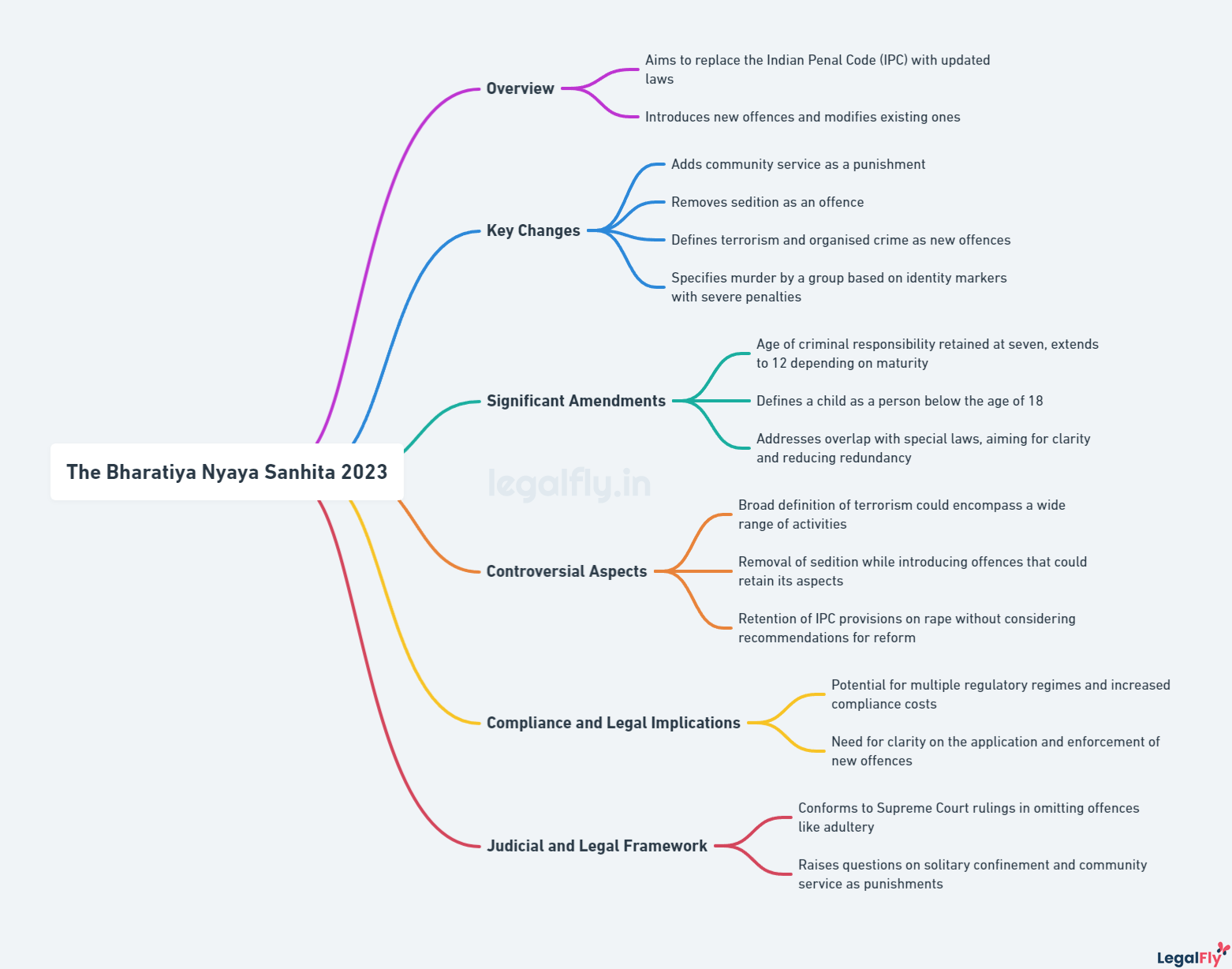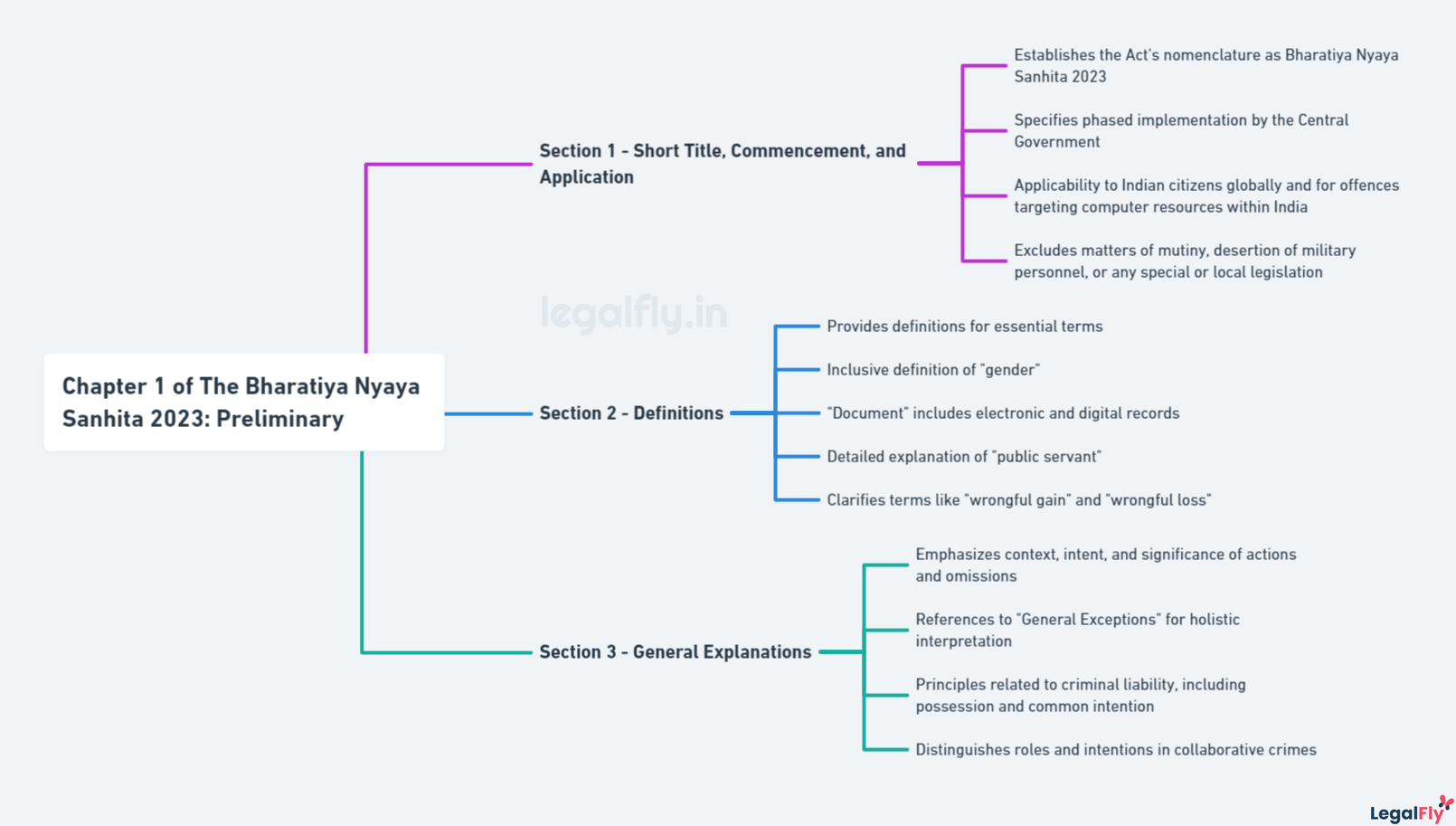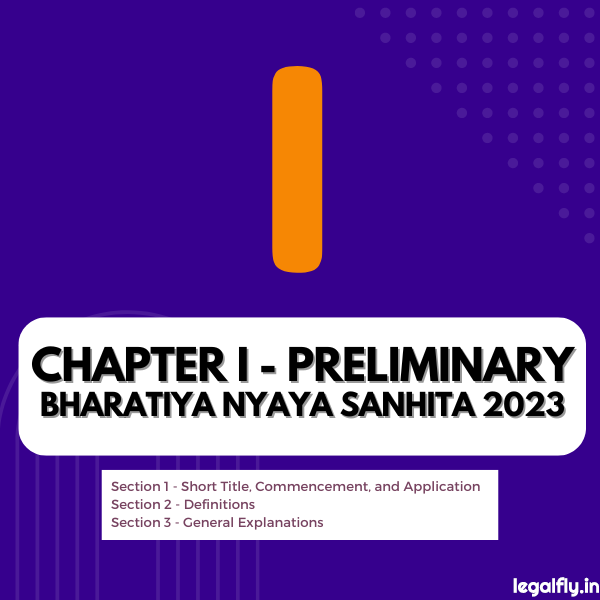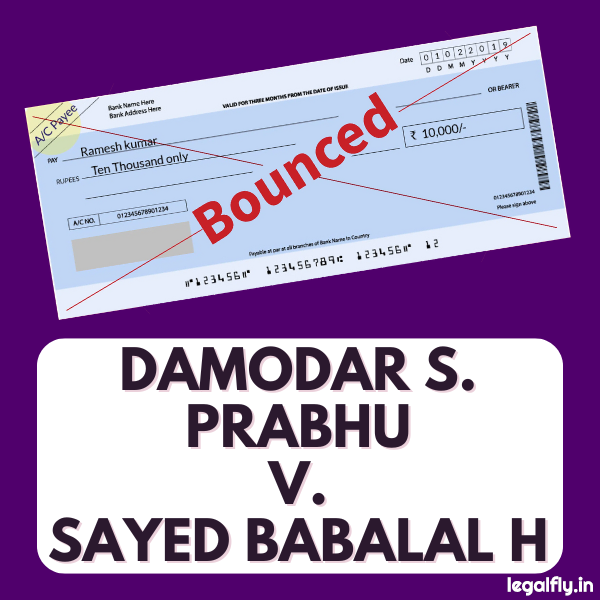Table of Contents
Introduction
The Indian government recently passed a landmark legislation called the Bharatiya Nyaya Sanhita (BNS) 2023. It represents a comprehensive overhaul of India’s criminal laws. This new Act aims to modernize, consolidate, and amend the existing penal and criminal procedure codes, which have remained unchanged since the colonial era.

We recently published a detailed study guide on the Bharatiya Nyaya Sanhita (BNS) 2023. This guide provides an overview of the Act, its purpose, historical context, and other essential aspects. We strongly recommend reading it before you start studying Chapter 1 of the Act for a better understanding.
Chapter 1 of The Bharatiya Nyaya Sanhita 2023 is the Act’s opening chapter. It establishes the fundamental framework, defines important terms, clarifies its applicability, and sets the scope of jurisdiction. To better understand how the Act works as an introduction, we will cover three sections in Chapter 1.
Overview of Chapter 1 of The Bharatiya Nyaya Sanhita 2023: Preliminary
Chapter 1 of The Bharatiya Nyaya Sanhita 2023 contains Sections 1 to 3 and establishes the Act’s framework, setting forth its nomenclature, applicability, and definitions critical for its interpretation throughout the subsequent chapters.
Section 1 of the Bharatiya Nyaya Sanhita 2023 states the Act’s official title and outlines its commencement and scope of application. This section establishes the foundation for a new legal framework in India that prioritizes justice and accountability within and globally. The Act will apply to acts committed by Indian citizens or against Indian interests, regardless of their location. The Central Government will determine the phased implementation of the Act’s provisions, ensuring a systematic and effective execution.
Section 2 of the Bharatiya Nyaya Sanhita 2023 covers the definitions and provides a comprehensive glossary. It aims to eliminate ambiguity and ensure precise interpretation across the provisions of the Sanhita. This section defines various terms, from basic to complex legal concepts. It also includes an inclusive approach to gender identity and a modern take on documents in the digital era. Legal professionals will find this section essential for understanding Sanhita’s scope and application in both traditional and contemporary contexts.

Section 3 explains the statute, emphasizing context, intent, and actions versus omissions in legal judgments. The section highlights that all aspects of the Sanhita, such as definitions and penal provisions, should be viewed together with the “General Exceptions” section to ensure a subtle approach to legal responsibility. This section is crucial in shaping our understanding of collective intention, the significance of omissions in crimes, and equitable liability among participants in a criminal act. It enriches the legal framework with clarity and fairness.
Section 1 – Short Title, Commencement, and Application
The Bharatiya Nyaya Sanhita 2023 is a significant development in India’s legal system, providing a framework for ensuring justice and accountability both within and outside the country’s boundaries. The Act, officially known as the Bharatiya Nyaya Sanhita 2023, is a crucial step in India’s commitment to upholding the rule of law. Its provisions will come into effect as designated by the Central Government through official notifications. This phased implementation approach will ensure the law’s introduction is efficient and effective.
The Bharatiya Nyaya Sanhita 2023 emphasizes that every individual, regardless of their location, is subject to the laws of India for any actions or omissions that go against the rules of this Sanhita. It is important to note that this law applies to acts committed by Indian citizens or on Indian-registered vessels and aircraft anywhere in the world, as well as offences that target computer resources located within India. This means India can take legal action against such individuals or groups, even outside India’s territorial limits. This is a significant step towards ensuring justice for crimes that affect the interests of India or its citizens, regardless of geographical boundaries.
Also, the Sanhita states that it will not interfere with existing laws pertaining to mutiny, desertion of military personnel, or any special or local legislation, thus preserving specialized legal provisions.
Section 2 – Definitions
Section 2 of Chapter 1 is an indispensable basis for the entire Sanhita as it offers accurate definitions for various essential terms vital for interpreting the law. This section defines various concepts in detail, ranging from fundamental elements like “act” and “animal” to more intricate legal terms such as “counterfeit” and “fraudulently.” This ensures clarity and avoids ambiguity in legal proceedings.
Section 2 of the Act has some key highlights that should be noted. Firstly, the definition of “gender” has been made inclusive, meaning it now covers male, female, and transgender individuals. This reflects India’s progressive stance on gender identity. Secondly, the section helps us understand the term “document” better by including electronic and digital records under its umbrella. This is in line with the digital age we live in. Thirdly, the term “public servant” has been explained in great detail. This covers a wide range of officials and emphasizes the extensive reach of the Act.
Furthermore, Section 2’s approach to defining terms such as “wrongful gain” and “wrongful loss” underscores Sanhita’s focus on justice and fairness, highlighting its aim to address and penalize unlawful gains at the expense of rightful owners.
Section 3 – General Explanations
Section 3 of Chapter 1 in the Bharatiya Nyaya Sanhita 2023 is a vital reference point for interpreting the law. It emphasizes the importance of context, intent, and the significance of actions and omissions in determining legal responsibility. This section states that all definitions, penal provisions, and examples in the Sanhita should be understood by considering the exceptions listed in the chapter on “General Exceptions”. This ensures that the law is interpreted holistically, with specific conditions such as a person’s age or actions required by the law being considered before labelling an act as an offence. For example, actions by children under seven years of age or duties performed by law enforcement without a warrant fall under these exceptions.
Section 3 of the law outlines important principles related to criminal liability. It explains that possession includes things managed by someone’s spouse, clerk, or servant on their behalf. Additionally, any criminal act or omission carried out with a common intention makes all participants equally responsible. This section also introduces the concept of criminal acts resulting from a combination of actions and omissions, expanding the range of legal accountability. For example, if a crime is committed through both direct actions and neglect, both forms of contribution are recognized as contributing to the offence. This is especially true in cases where neglect and physical harm jointly lead to a victim’s death.
Section 3 also highlights the collaborative nature of crimes. It demonstrates how different individuals can be accountable for distinct offences that arise from the same Act based on their roles and intentions. This distinction is crucial in cases where multiple parties are involved, ensuring that each person’s contribution and intent are accurately evaluated.




